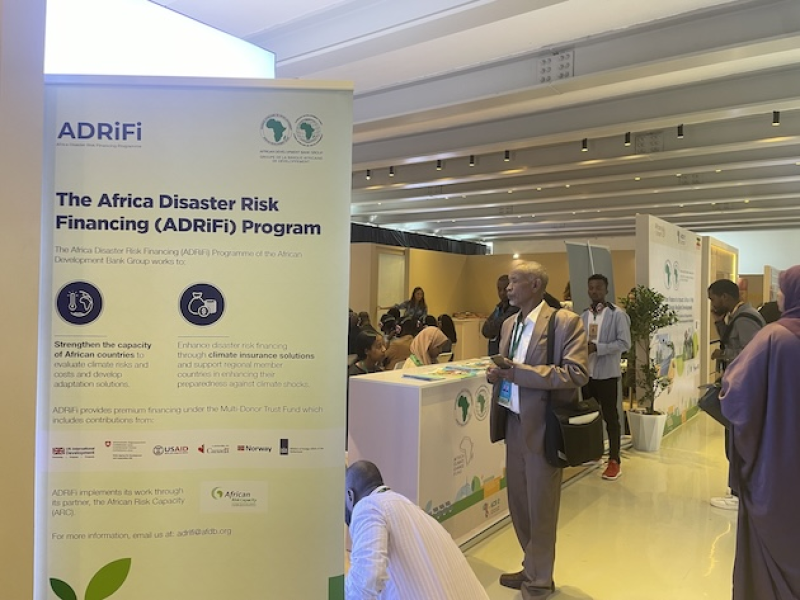- Indian MP Warns Bangladesh Faces Rising Lawlessness |
- Law and Order Must Be Ensured Ahead of Polls: Prof Yunus |
- Tough times ahead, everyone must remain united: Tarique Rahman |
- Sirajganj’s luxuriant mustard fields bloom as an oasis of gold |
- Man killed after boat hits sand-laden bulkhead on Padma River |
AfDB Pledges $11bn for Climate Resilience in Africa

Participants at the AfDB pavilion at the Second Africa Climate Summit in Addis Ababa, Ethiopia.
As increasingly frequent droughts and devastating floods erode agricultural productivity, leaving millions food insecure in Africa amid scarce climate finance, the African Development Bank (AfDB) has committed USD 11 billion to support climate-resilient and infrastructure projects in rural areas.
Climate change-induced humanitarian crises are now unfolding worldwide, often more frequently than predicted. In recent years, many countries have faced extreme weather events almost monthly. Poor nations in Africa have been the worst affected, bearing the brunt of climate change.
Africa is warming faster than the global average, according to a World Meteorological Organization (WMO) report released last year. The Horn of Africa, Southern Africa, and Northwest Africa have endured exceptional multi-year droughts, while other countries suffered significant casualties from extreme rainfall and floods in 2023.
James Kinyangi, coordinator of the Climate and Development Special Fund and the Climate Action Window at AfDB, said the bank is financing a wide range of climate adaptation and mitigation projects.
“AfDB has several ways of tackling climate challenges and integrating finance for climate action in its portfolio. Last year, we approved projects worth around USD 11 billion in African countries,” he said in an interview at the AfDB Pavilion during the Second Africa Climate Summit (ACS2) in Addis Ababa, Ethiopia, held from 8 to 10 September. The summit preceded the UN Climate Conference (COP30), to be hosted in Belém, Brazil, in November 2025.
“Of that amount, nearly half was dedicated to climate finance. Around USD 5 billion went to climate-related projects, with about 65 percent directed towards adaptation and the rest towards mitigation,” he explained.
Kinyangi added that nearly all new AfDB projects are now screened for climate impact, ensuring climate-informed design.
He highlighted the Climate Action Window under the African Development Fund, which has mobilised USD 500 million for 37 low-income African countries. So far, it has funded 41 adaptation projects and 18 mitigation projects.
According to the WMO, sub-Saharan Africa will require USD 30–50 billion annually for climate adaptation over the next decade. Without adequate financing, farmers in rural areas risk falling deeper into poverty by 2030 as national budgets are diverted.
AfDB’s investments span energy, agriculture, water resources, sanitation, forestry, climate information systems, and green projects. Many focus on rural resilience, including early warning systems, climate-smart agriculture, and clean cooking solutions.
In the Sahel, AfDB supports Farmer Managed Natural Regeneration (FMNR), a low-cost practice where farmers manage natural tree growth to restore degraded soil, boosting yields and food security. Across Africa, AfDB backs climate-smart agriculture, reaching 20 million farmers with technologies like drought insurance, water harvesting, and renewable energy.
In Zimbabwe, AfDB partners with IFAD and UNICEF on school feeding programmes, providing solar-powered cold chains for vaccines and medication delivery. The bank is also converting irrigation systems from diesel to solar.
Many African countries exposed to droughts and floods divert budgets from health and education to disaster response, often resorting to borrowing. Debt restructuring efforts, such as the G20 Common Framework, have been slow, with only Ghana and Zambia benefiting since 2020.
Between 2010 and 2020, Africa’s external debt grew more than fivefold, reaching nearly 65% of GDP by 2023. Although projected to fall slightly by 2025, the continent still faces an escalating debt crisis, with 25 countries at high risk of debt distress in 2024.
Kinyangi said the AfDB Climate Action Window was created to help such vulnerable states. “Countries like Mozambique, Malawi, and Zimbabwe, often hit by tropical cyclones, must divert national resources, leaving budget holes that force borrowing. Our goal is to channel climate finance directly to resilience-building, so budgets for education, health, and infrastructure are protected.”
At ACS2, AfDB joined other banks in committing to mobilise USD 100 billion for green industrial projects. African leaders also pledged to raise USD 50 billion annually for climate solutions, though the continent still requires USD 1.3 trillion per year for its adaptation plans, according to the African Union.

